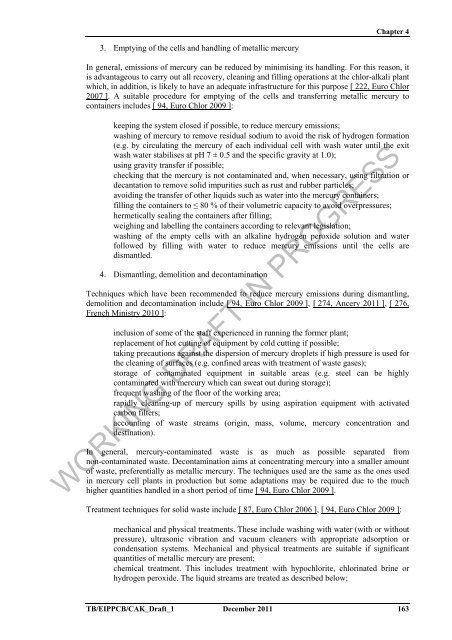(BAT) Reference Document for the Production of Chlor-alkali ...
(BAT) Reference Document for the Production of Chlor-alkali ...
(BAT) Reference Document for the Production of Chlor-alkali ...
You also want an ePaper? Increase the reach of your titles
YUMPU automatically turns print PDFs into web optimized ePapers that Google loves.
3. Emptying <strong>of</strong> <strong>the</strong> cells and handling <strong>of</strong> metallic mercury<br />
Chapter 4<br />
In general, emissions <strong>of</strong> mercury can be reduced by minimising its handling. For this reason, it<br />
is advantageous to carry out all recovery, cleaning and filling operations at <strong>the</strong> chlor-<strong>alkali</strong> plant<br />
which, in addition, is likely to have an adequate infrastructure <strong>for</strong> this purpose [ 222, Euro <strong>Chlor</strong><br />
2007 ]. A suitable procedure <strong>for</strong> emptying <strong>of</strong> <strong>the</strong> cells and transferring metallic mercury to<br />
containers includes [ 94, Euro <strong>Chlor</strong> 2009 ]:<br />
keeping <strong>the</strong> system closed if possible, to reduce mercury emissions;<br />
washing <strong>of</strong> mercury to remove residual sodium to avoid <strong>the</strong> risk <strong>of</strong> hydrogen <strong>for</strong>mation<br />
(e.g. by circulating <strong>the</strong> mercury <strong>of</strong> each individual cell with wash water until <strong>the</strong> exit<br />
wash water stabilises at pH 7 ± 0.5 and <strong>the</strong> specific gravity at 1.0);<br />
using gravity transfer if possible;<br />
checking that <strong>the</strong> mercury is not contaminated and, when necessary, using filtration or<br />
decantation to remove solid impurities such as rust and rubber particles;<br />
avoiding <strong>the</strong> transfer <strong>of</strong> o<strong>the</strong>r liquids such as water into <strong>the</strong> mercury containers;<br />
filling <strong>the</strong> containers to Q 80 % <strong>of</strong> <strong>the</strong>ir volumetric capacity to avoid overpressures;<br />
hermetically sealing <strong>the</strong> containers after filling;<br />
weighing and labelling <strong>the</strong> containers according to relevant legislation;<br />
washing <strong>of</strong> <strong>the</strong> empty cells with an <strong>alkali</strong>ne hydrogen peroxide solution and water<br />
followed by filling with water to reduce mercury emissions until <strong>the</strong> cells are<br />
dismantled.<br />
4. Dismantling, demolition and decontamination<br />
Techniques which have been recommended to reduce mercury emissions during dismantling,<br />
demolition and decontamination include [ 94, Euro <strong>Chlor</strong> 2009 ], [ 274, Ancery 2011 ], [ 276,<br />
French Ministry 2010 ]:<br />
inclusion <strong>of</strong> some <strong>of</strong> <strong>the</strong> staff experienced in running <strong>the</strong> <strong>for</strong>mer plant;<br />
replacement <strong>of</strong> hot cutting <strong>of</strong> equipment by cold cutting if possible;<br />
taking precautions against <strong>the</strong> dispersion <strong>of</strong> mercury droplets if high pressure is used <strong>for</strong><br />
<strong>the</strong> cleaning <strong>of</strong> surfaces (e.g. confined areas with treatment <strong>of</strong> waste gases);<br />
storage <strong>of</strong> contaminated equipment in suitable areas (e.g. steel can be highly<br />
contaminated with mercury which can sweat out during storage);<br />
frequent washing <strong>of</strong> <strong>the</strong> floor <strong>of</strong> <strong>the</strong> working area;<br />
rapidly cleaning-up <strong>of</strong> mercury spills by using aspiration equipment with activated<br />
carbon filters;<br />
accounting <strong>of</strong> waste streams (origin, mass, volume, mercury concentration and<br />
destination).<br />
In general, mercury-contaminated waste is as much as possible separated from<br />
non-contaminated waste. Decontamination aims at concentrating mercury into a smaller amount<br />
<strong>of</strong> waste, preferentially as metallic mercury. The techniques used are <strong>the</strong> same as <strong>the</strong> ones used<br />
in mercury cell plants in production but some adaptations may be required due to <strong>the</strong> much<br />
higher quantities handled in a short period <strong>of</strong> time [ 94, Euro <strong>Chlor</strong> 2009 ].<br />
WORKING DRAFT IN PROGRESS<br />
Treatment techniques <strong>for</strong> solid waste include [ 87, Euro <strong>Chlor</strong> 2006 ], [ 94, Euro <strong>Chlor</strong> 2009 ]:<br />
mechanical and physical treatments. These include washing with water (with or without<br />
pressure), ultrasonic vibration and vacuum cleaners with appropriate adsorption or<br />
condensation systems. Mechanical and physical treatments are suitable if significant<br />
quantities <strong>of</strong> metallic mercury are present;<br />
chemical treatment. This includes treatment with hypochlorite, chlorinated brine or<br />
hydrogen peroxide. The liquid streams are treated as described below;<br />
TB/EIPPCB/CAK_Draft_1 December 2011 163







